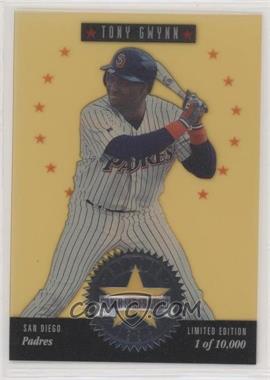Difference between revisions of "Acetate"
| (2 intermediate revisions by the same user not shown) | |||
| Line 1: | Line 1: | ||
| − | '''Acetate:''' A thin, but sturdy transparent plastic. Cards made out of acetate were pioneered by draft pick manufacturer Classic in the early 90s, and are | + | '''Acetate:''' A thin, cheap, but sturdy transparent plastic. Cards made out of acetate were pioneered by draft pick manufacturer Classic in the early 90s, and were used throughout the decade. Unfortunately, acetate has a tendency to "yellow" over time when exposed to sunlight -- which is why it is rarely used on trading cards anymore. |
| + | |||
| + | https://img.comc.com/i/Baseball/1994/Studio---Series-Stars---Silver/1/Tony-Gwynn.jpg?id=2918f35f-1959-4b32-88a2-9b216c6ec538&size=original&side=front&.jpg | ||
| + | |||
| + | Most "acetate" cards made today are actually made of polyethylene terephthalate glycol or PETG. Like acetate, PETG is clear, sturdy, cheap to produce, and thin enough to be used in trading cards. Unlike acetate, PETG does not "yellow" over time like acetate. | ||
[[Category: Hobby Definitions]] | [[Category: Hobby Definitions]] | ||
Latest revision as of 18:16, 13 January 2021
Acetate: A thin, cheap, but sturdy transparent plastic. Cards made out of acetate were pioneered by draft pick manufacturer Classic in the early 90s, and were used throughout the decade. Unfortunately, acetate has a tendency to "yellow" over time when exposed to sunlight -- which is why it is rarely used on trading cards anymore.

Most "acetate" cards made today are actually made of polyethylene terephthalate glycol or PETG. Like acetate, PETG is clear, sturdy, cheap to produce, and thin enough to be used in trading cards. Unlike acetate, PETG does not "yellow" over time like acetate.